

Intégration continue des projets PHP avec Jenkins. Intégration continue d'un projet PHP avec Jenkins. Cet article fait suite à Intégration continue avec Jenkins : installation et configuration de base — et pré-suppose que vous avez installé une plate-forme d’Intégration Continue Jenkins, avec les plugins qui seront nécessaires à la mise en intégration continue d’un projet PHP.
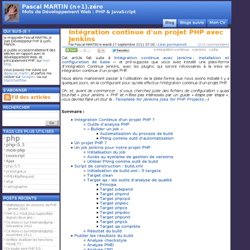
Nous allons maintenant passer à l’utilisation de la plate-forme que nous avons installé il y a quelques jours, en la configurant pour qu’elle effectue l’intégration continue d’un projet PHP. Types of PHP Framework: Glue and Full-Stack. PHP frameworks are in great news from 1-2 years in PHP community.
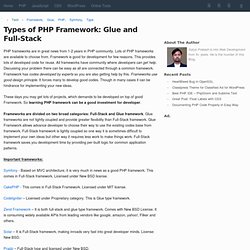
Lots of PHP frameworks are available to choose from. Framework is good for development for few reasons. This provides lots of developed code for reuse. All frameworks have community where developers can get help. Discussing your problem there can be easy as all are connected through a common framework. These days you may get lots of projects, which demands to be developed on top of good Framework. Frameworks are divided on two broad categories: Full-Stack and Glue framework. Important frameworks: Ecrire un Web Service en PHP – Partie 3 – Mettre en œuvre et déployer le service, appel par un client. Nous allons continuer notre apprentissage des Web Services dans cette troisième partie.
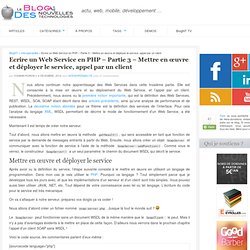
Elle est consacrée à la mise en œuvre et au déploiement du Web Service, et l’appel par un client. Précédemment, nous avons vu la première notion importante, qui est la définition des Web Services, REST, WSDL, SOA, SOAP étant décrit dans des articles précédents, ainsi qu’une analyse de performance et de publication. Theodo - Développement Symfony agile - Business intelligence Python. 50 Extremely Useful PHP Tools. Advertisement By Jacob Gube PHP is one of the most widely used open-source server-side scripting languages that exist today.
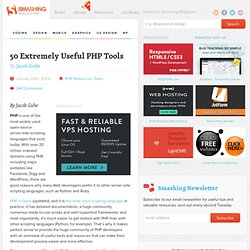
With over 20 million indexed domains using PHP, including major websites like Facebook, Digg and WordPress, there are good reasons why many Web developers prefer it to other server-side scripting languages, such as Python and Ruby. PHP is faster (updated), and it is the most used scripting language in practice; it has detailed documentation, a huge community, numerous ready-to-use scripts and well-supported frameworks; and most importantly, it’s much easier to get started with PHP than with other scripting languages (Python, for example). That’s why it makes perfect sense to provide the huge community of PHP developers with an overview of useful tools and resources that can make their development process easier and more effective.
Comparatif des hébergeurs PHP gratuits. Voici un comparatif des meilleurs hébergeurs gratuits acceptant le langage PHP.
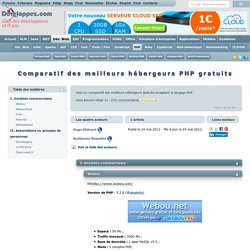
Vous pouvez réagir ici : 239 commentaires. Tests unitaires et couverture de code. Les tests unitaires sont au développeur ce que la prose est à M.
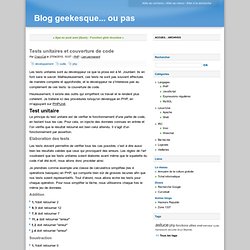
Jourdain: ils en font sans le savoir. Malheureusement, ces tests ne sont pas souvent effectués de manière complète et approfondie, et le développeur ne s'intéresse pas au complément de ces tests: la couverture de code. Heureusement, il existe des outils qui simplifient ce travail et le rendent plus cohérent. Je traiterai ici des procédures lorsqu'on développe en PHP, en m'appuyant sur PHPUnit. Test unitaire Le principe du test unitaire est de vérifier le fonctionnement d'une partie de code, en testant tous les cas. Elaboration des tests Les tests doivent permettre de vérifier tous les cas possible, c'est à dire aussi bien les résultats valides que ceux qui provoquent des erreurs.
PHPUnit : tests unitaires pour PHP. PHP SOAP Extension. Introduction A PHP SOAP Extension can be used to provide and consume Web services.
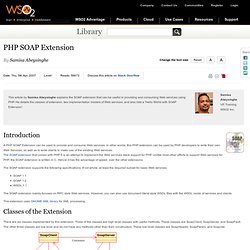
In other words, this PHP extension can be used by PHP developers to write their own Web Services, as well as to write clients to make use of the existing Web services. The SOAP extension that comes with PHP 5 is an attempt to implement the Web services stack support for PHP. Unlike most other efforts to support Web services for PHP, the SOAP extension is written in C. Hence it has the advantage of speed, over the other extensions.
Www.entreprise-agile.com/MoteurProjetFR.pdf. Testing with PHPUnit and Selenium. NetBeans IDE for PHP supports PHPUnit automated tests.
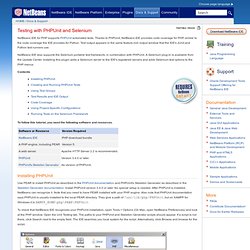
Thanks to PHPUnit, NetBeans IDE provides code coverage for PHP, similar to the code coverage the IDE provides for Python. Test output appears in the same feature-rich output window that the IDE's JUnit and Python test runners use. NetBeans IDE also supports the Selenium portable test framework, in combination with PHPUnit. A Selenium plug-in is available from the Update Center. Installing this plugin adds a Selenium server to the IDE's registered servers and adds Selenium test options to the PHP menus.
Contents To follow this tutorial, you need the following software and resources. Installing PHPUnit Use PEAR to install PHPUnit as described in the PHPUnit documentation and PHPUnit's Skeleton Generator as described in the Skeleton Generator documentation. To check that NetBeans IDE recognizes your PHPUnit installation, open Tools > Options (On Mac, open NetBeans Preferences) and look at the PHP window. Installing PEAR and PHPUnit on WAMP and Windows 7. Object Oriented PHP Memory Concerns. It’s hard to imagine pushing the limits of object oriented PHP so far that your web servers choke, but the truth is those limits are reached faster than you think.
We’ve run some tests over at Wufoo and it turns out that any sort of mass object creation is pretty much not going to work at scale. The problem is this limit on object creation forces developers to balance code consistency, which is desirable—especially for the old-schoolers, with performance. While replacing objects with arrays when possible makes things a little better, the most performance friendly approach involves appending strings. For your convenience, we’ve run some tests that measure page execution times and memory usage to create the following guideline to help you plan out what areas of your code may have to break away from an object oriented nature.
The Benchmarks Load Time Memory Used Control. Www.fdi.ucm.es/profesor/jlsierra/e-learning/segunda-sesion/XMLParsingModels.pdf.